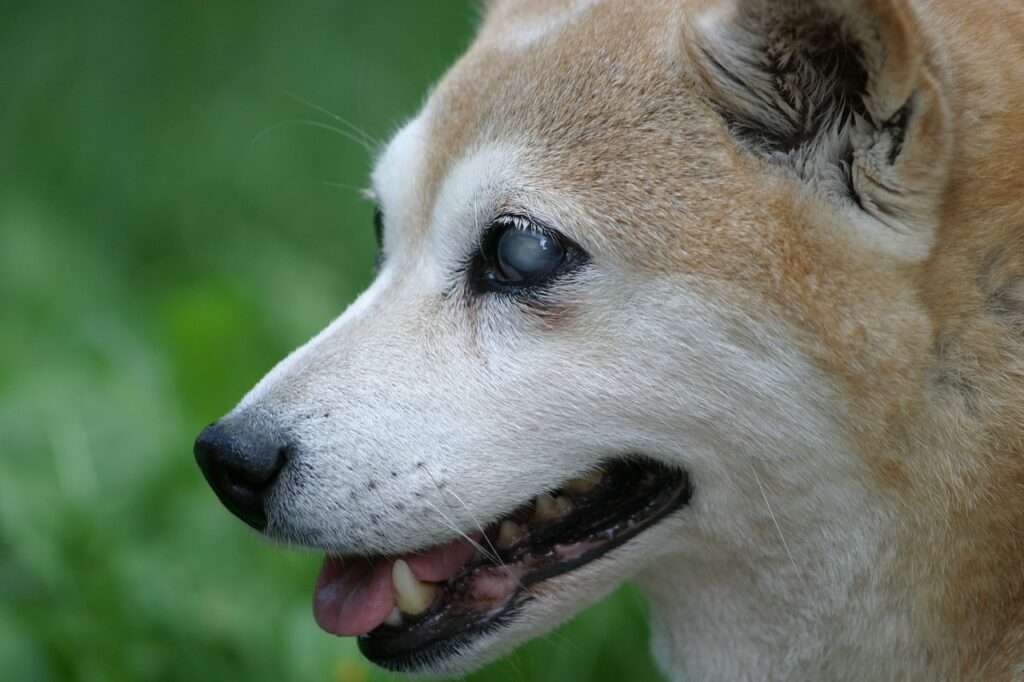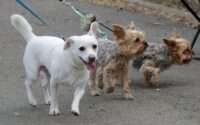Leaving a Blind Dog Alone? Follow These Expert Tips for Peace of Mind
Welcome to our comprehensive guide on leaving a blind dog alone. At BarkLikeMeow, we understand that our furry friends require special attention and care, particularly when they face challenges such as vision loss.
In this article, we will delve into every aspect of ensuring the safety and comfort of your blind dog when you can’t be by their side. By following our expert advice and implementing the recommended strategies, you can provide a nurturing environment for your blind dog even when they are alone.
Understanding Blindness in Dogs
Blindness in dogs can be caused by various factors, ranging from genetic conditions to diseases or injuries. Identifying the signs and symptoms of vision loss in your dog is crucial for their overall well-being.
Common signs include bumping into objects, reluctance to move in unfamiliar areas, and difficulty tracking moving objects. Regular visits to a veterinarian specializing in ophthalmology are essential to diagnose the underlying cause and ensure appropriate care.
Preparing the Environment
Creating a safe and accessible space for your blind dog is paramount to their comfort and safety when they are left alone. It is recommend to take proactive measures to remove potential obstacles and hazards that can pose risks to your furry friend.
By incorporating tactile cues and markers, such as textured mats or carpet runners, you can help guide your blind dog and provide them with a predictable layout. Additionally, pet-proofing your living space can prevent accidents and reduce the likelihood of injury.
Promoting Mental Stimulation
Mental enrichment plays a crucial role in the overall well-being of blind dogs. Despite their visual impairment, they possess other keen senses that can be engaged to keep them mentally stimulated and fulfilled. Interactive toys and puzzles designed specifically for blind dogs can provide entertainment and mental exercise. By incorporating these toys into their daily routine, you can help prevent boredom and promote cognitive development.
Additionally, engaging their other senses—such as hearing, smell, and touch—can provide sensory enrichment. Consider introducing toys or activities that produce sounds or have distinct scents. Engaging in training exercises that rely on their sense of smell can also provide mental stimulation and reinforce their bond with you. Remember, a mentally stimulated blind dog is a content and fulfilled companion.
Establishing a Routine
Creating a consistent daily routine is essential for the well-being of blind dogs. A predictable schedule helps them feel secure and reduces anxiety when left alone. When creating a routine for your blind dog, consider their feeding and watering times, exercise and potty breaks, and bedtime rituals.
Ensure that mealtimes are consistent and take place in a familiar location. Establish a designated area for potty breaks and maintain a regular exercise regimen to keep them physically active and mentally engaged. Incorporating obedience training sessions into their routine can also provide structure and mental stimulation.
By establishing a predictable bedtime routine, you can help your blind dog feel secure and ready for rest. Consider activities such as a calming massage or providing a comfortable sleeping area with familiar scents. Consistency is key when it comes to establishing a routine for your blind dog’s well-being.
Technology and Tools for Assistance
Advancements in technology have opened up a world of possibilities to assist blind dogs in their daily lives. These innovative tools can provide an extra layer of safety and convenience, especially when your furry friend is left alone.
GPS trackers are one such tool that can help ensure the safety of blind dogs during walks or outdoor adventures. These devices allow you to keep track of their whereabouts and quickly locate them if they happen to wander off. With real-time tracking capabilities, you can have peace of mind knowing that your blind dog is within a safe range.
Remote monitoring systems have also become popular among pet owners, and they offer a valuable solution for keeping an eye on your blind dog when you’re away. These systems typically include cameras or sensors that allow you to check in on your furry friend via your smartphone or computer. You can observe their behavior, ensure they are comfortable, and even interact with them remotely.
Innovative technologies specifically designed for blind dogs are continuously emerging. From wearable devices that emit audible cues to assist with navigation, to smart feeding systems that dispense meals on a preset schedule, these advancements aim to enhance the independence and well-being of your blind dog even when they are alone.
Separation Anxiety and Coping Strategies
Separation anxiety can be a common challenge when leaving a blind dog alone. The inability to rely on their vision may intensify their anxiety levels. However, with the right approach and understanding, you can help alleviate their distress and make their alone time more manageable.
Positive reinforcement techniques are key when dealing with separation anxiety in blind dogs. By associating positive experiences with your departure, such as providing special treats or engaging in calming activities before you leave, you can help create a positive association with alone time. Gradual desensitization, where you gradually increase the duration of your absence, can also help your blind dog adjust and build confidence.
Creating a comforting environment for your blind dog is essential. Leaving familiar scents, such as an unwashed blanket or an item with your scent, can provide a sense of security. Additionally, leaving on soothing music or white noise can help drown out external sounds and create a calming atmosphere.
If the separation anxiety persists or becomes severe, seeking professional help is highly recommended. Dog behaviorists and trainers specialized in anxiety-related issues can provide targeted strategies and personalized guidance. They can develop a customized behavior modification plan that addresses your blind dog’s specific needs, helping them build confidence and manage their anxiety.
Seeking Professional Help
Sometimes the journey of caring for a blind dog may present unique challenges. That’s why seeking professional help is crucial to ensure your blind dog receives the specialized care they deserve. Veterinary professionals experienced in ophthalmology can provide accurate diagnoses and develop tailored treatment plans for your furry friend.
Dog behaviorists are another valuable resource for blind dog owners. These experts can help address specific behavioral challenges that may arise from vision loss and separation anxiety. With their guidance, you can implement positive reinforcement techniques, desensitization exercises, and other strategies to ensure your blind dog feels comfortable and confident even when left alone.
Moreover, blind dog support groups and online communities offer a wealth of knowledge and a platform to connect with other pet owners facing similar situations. Sharing experiences, seeking advice, and receiving emotional support from individuals who understand the unique journey of caring for a blind dog can be invaluable.
Tips for a Successful Alone Time
The thought of leaving a blind dog alone can oftentimes be a daunting experience. However, with careful preparation and the right strategies, you can help ensure a successful and stress-free time apart. Here are some practical tips to help you create a safe and comfortable environment for your blind dog when they are left alone:
- Gradual training: Start by leaving your blind dog alone for short periods and gradually increase the duration over time. This helps them build confidence and trust in their ability to be alone.
- Comforting scents and familiar sounds: Leave behind items with familiar scents, such as an unwashed blanket or a piece of clothing, to provide a sense of security. Additionally, consider playing soft, calming music or leaving on a TV or radio at a low volume to provide familiar sounds that can help ease anxiety.
- Calming aids: Explore the use of natural calming aids, such as pheromone diffusers or sprays, which can help create a soothing atmosphere for your blind dog.
- Regular check-ins: If possible, check in on your blind dog periodically using technology, such as home security cameras or pet monitoring systems. Seeing your face or hearing your voice can provide reassurance and comfort to your furry friend.
Remember, every dog is unique, so it’s essential to observe your blind dog’s behavior and adjust these tips accordingly. By implementing these strategies, you can help ensure a successful alone time for your blind dog and alleviate any potential anxiety.
Emergency Preparedness
Being prepared for any situation, including emergencies, is crucial when caring for a blind dog. When caring for a blind dog, it’s important to have an emergency plan in place to ensure their safety and well-being. Here are some steps you can take to prepare for unforeseen circumstances:
- Identify emergency contacts: Maintain a list of emergency contacts, including your veterinarian’s number, an after-hours veterinary clinic, and a trusted neighbor or friend who can assist in case of an emergency.
- Create a disaster kit: Assemble a disaster kit that includes essential items for your blind dog, such as food, water, medications, a leash, identification tags, and a copy of their medical records. Keep the kit in an easily accessible location.
- Plan for evacuation: If you need to evacuate your home due to a natural disaster or other emergency, ensure you have a plan in place for safely transporting your blind dog. Consider having a carrier or harness readily available for easy and secure transportation.
- Display clear identification: Ensure your blind dog wears a collar with updated identification tags, including your contact information. In case they become separated from you during an emergency, this will increase the chances of a safe reunion.
By taking these precautionary measures, you can be better prepared to handle emergencies and prioritize the safety of your blind dog. Remember to review and update your emergency plan regularly to account for any changes in your dog’s needs or circumstances.
Traveling and Boarding Considerations

Traveling or boarding with a blind dog can pose specific challenges that require careful planning and consideration. Ensuring the safety and comfort of your furry friend during these periods is essential. Here are some important factors to keep in mind:
- Planning ahead: Research blind dog-friendly accommodations or boarding facilities that have experience and understanding of the specific needs of visually impaired dogs. Ensure they have appropriate measures in place to provide a safe and comfortable environment.
- Introducing new environments: When traveling or boarding, it’s important to gradually introduce your blind dog to new environments. Allow them time to acclimate to the surroundings and provide familiar scents or items from home to help them feel more secure.
- Communicating specific needs: When making arrangements for your blind dog, communicate their specific needs to the staff or caregivers. Provide instructions on their routine, feeding preferences, any medication requirements, and any additional accommodations they may need.
- Familiarizing with the surroundings: If possible, visit the location or facility before the actual travel or boarding date. This allows your blind dog to familiarize themselves with the space and become more comfortable in the new environment.
Remember, each blind dog is unique, so it’s important to consider their individual needs and comfort levels when traveling or boarding. By taking these considerations into account, you can ensure a positive experience for your blind dog, even in unfamiliar surroundings.
Conclusion
In conclusion, leaving a blind dog alone requires careful attention and preparation to ensure their safety, comfort, and well-being. At BarkLikeMeow, we understand the unique challenges faced by blind dog owners and have provided this comprehensive guide to assist you in creating a nurturing environment for your furry companion.
By understanding blindness in dogs, preparing the environment, promoting mental stimulation, establishing a routine, utilizing technology and tools for assistance, addressing separation anxiety, seeking professional help when needed, and being prepared for emergencies, you can provide the best care for your blind dog even when you cannot be with them.
We are committed to providing you with the guidance and resources needed to ensure the happiness and safety of your blind dog. By following our expert advice and showing empathy and understanding, you can create a loving and supportive environment for your blind dog, fostering their independence, confidence, and overall well-being.
Thank you for choosing us as your trusted resource for all things related to caring for your blind dog. We wish you and your furry friend a lifetime of love, joy, and companionship.
Frequently Asked Questions
Q: Can blind dogs be left alone?
A: Yes, blind dogs can be left alone. However, it requires careful preparation and consideration to ensure their safety and well-being during this time.
Q: How long can I leave my blind dog alone?
A: The duration of time you can leave your blind dog alone will depend on various factors, including their individual needs, comfort levels, and overall health. It’s important to gradually train them for longer periods of solitude and monitor their behavior and well-being during those times.
Q: How can I make my blind dog feel comfortable when left alone?
A: Creating a safe and accessible environment, incorporating familiar scents or sounds, and utilizing positive reinforcement techniques can help make your blind dog feel more comfortable when left alone.
Q: How do I prevent separation anxiety in my blind dog?
A: Preventing separation anxiety in blind dogs requires gradual desensitization, positive reinforcement, and providing a comforting environment. Consulting with a professional, such as a dog behaviorist, can also be beneficial in managing separation anxiety.
Q: Are there any specific toys or activities recommended for blind dogs when left alone?
A: Yes, there are interactive toys and puzzles designed specifically for blind dogs that can provide mental stimulation and entertainment. Toys that stimulate their other senses, such as hearing or smell, can be particularly beneficial.
Q: Should I use technology to monitor my blind dog when I’m away?
A: Using technology, such as home security cameras or pet monitoring systems, can provide peace of mind and allow you to check in on your blind dog periodically. However, it’s important to ensure their privacy and safety when utilizing such technology.
Q: What should I do in case of an emergency when my blind dog is alone?
A: Having an emergency plan in place is crucial. Ensure you have a list of emergency contacts, a disaster kit with essential supplies, and clear identification for your blind dog. Reviewing and updating the plan regularly is important.
Q: Are there any specific considerations for leaving a blind dog alone outdoors?
A: Leaving a blind dog alone outdoors requires extra caution and preparation. Ensure that the outdoor area is fully enclosed and secure, minimizing potential hazards. Providing shelter from extreme weather conditions and access to fresh water is essential. Regular supervision and avoiding leaving them unattended for extended periods are important measures to safeguard their safety and well-being.
Remember, every blind dog is unique, so it’s essential to observe their behavior and adjust your approach accordingly. Consulting with professionals and seeking personalized advice can greatly assist in addressing any specific concerns or challenges related to leaving a blind dog alone.
References
- WagWalking. (n.d.). Blindness in Dogs: Causes, Symptoms, and Treatment. Retrieved from https://wagwalking.com/condition/blindness
- Top Dog Tips. (n.d.). How to Care for a Blind Dog: A Comprehensive Guide. Retrieved from https://topdogtips.com/how-to-care-for-a-blind-dog/
- Care.com. (n.d.). 17 Tips for Living with a Blind Dog. Retrieved from https://www.care.com/c/17-tips-for-living-with-a-blind-dog/
- Humane Society of the United States. (n.d.). How to Care for Blind Pets. Retrieved from https://www.humanesociety.org/resources/how-care-blind-pets




